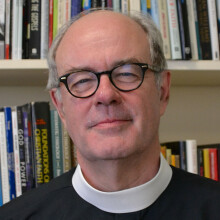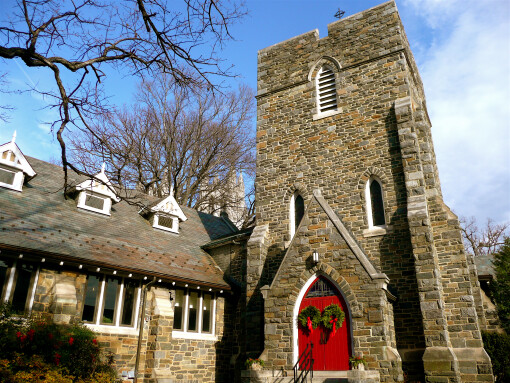Not Peace But a Sword - No Paz, Sino Espada

Series: Pentecost
Speaker: Geoffrey Hoare and Yoimel Gonzalez
Translator: The Rev'd Yoimel González Hernández
Mira debajo para acceder a la traducción al español.
The Story of St. Alban is familiar to some of us and not to others. Venerated as the first English Martyr, there does not appear to be any equivalent saint in Latin culture. In short, during a persecution of Christians in the 3rd century, Alban sheltered a priest who was later known as Amphibalus (which means ‘cloak’). The priest’s devotion to his faith impressed Alban such that he too accepted Christ. When the priest’s whereabouts was discovered, soldiers came to arrest him but Alban took the priest’s cloak and was arrested in his stead. The judge was infuriated and eventually sentenced Alban to death. There is much more color to the story including wells springing up and eyes popping out, but in the end, Alban died by the sword and was beheaded, refusing to recant his Christian faith. When Barbara Brown Taylor was with us just before the shutdown, one visitor pointed out the sword in the Alban window and assumed a kind of glorification of violence. In fact, the intent of the window is quite the reverse, --the sword functioning for Alban much as the cross functions in the story of Jesus as an instrument of cruel injustice at the hand of a flawed system. The Story of St. Alban is familiar to some of us and not to others. Venerated as the first English Martyr, there does not appear to be any equivalent saint in Latin culture. In short, during a persecution of Christians in the 3rd century, Alban sheltered a priest who was later known as Amphibalus (which means ‘cloak’). The priest’s devotion to his faith impressed Alban such that he too accepted Christ. When the priest’s whereabouts was discovered, soldiers came to arrest him but Alban took the priest’s cloak and was arrested in his stead. The judge was infuriated and eventually sentenced Alban to death. There is much more color to the story including wells springing up and eyes popping out, but in the end, Alban died by the sword and was beheaded, refusing to recant his Christian faith. When Barbara Brown Taylor was with us just before the shutdown, one visitor pointed out the sword in the Alban window and assumed a kind of glorification of violence. In fact, the intent of the window is quite the reverse, --the sword functioning for Alban much as the cross functions in the story of Jesus as an instrument of cruel injustice at the hand of a flawed system.
The Gospel appointed for our patronal feast also refers to the sword where Jesus says: “Do not think that I have come to bring peace to the earth; I have not come to bring peace , but a sword.” These are troubling words from the one we know as ‘the Prince of Peace,’ at least until we recognize that for the hearers of Matthew’s Gospel, division, --even within families—was part of their experience of deciding to follow Jesus. In 90 CE, at the Council of Jabneh or Jamnia is understood to be the time when canon of the Hebrew Scriptures was finalized, partly in response to the writings of the Christian movement, and when Jewish authorities decided to exclude those who believed in Jesus as the Messiah. The reality of division was a real part of the experience of following Jesus.
And division, even in some of our family relationships, is clearly part of our experience today, is it not? The coronavirus had laid bare the disproportionate effects it has on Black and Brown people, both in contracting the disease; and in being in front line positions that increase their risk of contracting COVID-19; and in becoming unemployed. Add to that the murders of Ahmaud Arbery and George Floyd and the gaping wound of racism in our society is once again laid bare. One of our challenges in the combustible atmosphere of these days is to make sure that we are responding to what it means to follow Jesus and not simply resorting to some kind of partisan political tribalism. This is doubly difficult when divisions between Christians reflect those same partisan divisions. So, let’s look again at the Scripture.
What kind of peace is it that Jesus did not come to bring? We know that he came to bring the shalom of God, the peace that surpasses human understanding, the peace that is marked by justice. So, what kind of peace did he not come to bring? Well, the other kind of peace is the kind that brings superficial peace, --not necessarily a bad think in itself. This peace is often marked by ‘law and order’, achieved by maintaining clear boundaries over against others. This social peace often removes from sight the potentially destabilizing problems within society and always carries a price for those who end up being the excluded victims of such a social order. Jesus did not come to bring that kind of peace which is always unstable unless or until we learn to listen, love, forgive and have a change of heart in the face of difference, rather than metaphorically sweeping issues under a rug. I believe that the divisions we are seeing are being brought to light, at least in part, by a growing sense that Jesus stands with the poor, the victim, the outsider, the societal loser. And so that is where we must stand as well, ever seeking a more just society and calling out those who perpetuate racism today.
Jesus’ message is not only opposition to false peace however, but also welcome. The prophets who carry a liberating life-giving message are welcomed. The righteous person, the seeker of right relationship between and for all people is welcomed. And the one who cares for and serves the vulnerable in society is welcomed.
Many have asked ‘what can we do?’ or ’How can the Church respond?’ The fest of St. Alban reminds us that we are one parish and we worship in two languages. Why not start there, finding ways to get to know each other and really listen to the diversity of human experience that we bring when we come together? Our staff will find some programmatic ways of doing that, but it will not substitute for our sharing of stories of our real experience in this world.
Have you ever seen the movie or read the book The Help? It is about the power of stories to help bring about societal change. A Black maid in Mississippi had the courage to talk to a White journalist that she knew slightly about the reality of her experience. In time others joined her in telling their stories. In the end some real change came about in their community. It is a book worth reading and a movie worth seeing. Can we not start there as well, listening to the stories of others and sharing our own? Is that not how Alban became a Christian in the first place, --by recognizing the beauty in the faith of a stranger?
From there we can and must advocate for a vision of society founded in our understanding of the reign of God, but we can begin right here in the community named for St. Alban, --a saint whose story is alien to many but whose faith is recognizable to all of us. There is reason to hope as we are not cowed by the forces for whom division and control seem the better way. There is reason for us to have holy hope when we follow the Prince of Peace together.
We offer this in the name of the Father and of the Son and of the Holy Spirit. AMEN
NO PAZ, SINO ESPADA
La historia de San Albano nos es familiar a algunos de nosotros y no a otros. Venerado como el primer mártir inglés, no parece haber ningún santo equivalente en la cultura latina. En resumen, durante una persecución de cristianos en el siglo III, Albano albergó a un sacerdote que más tarde se conoció como Amphibalus (que significa "capa"). La devoción del sacerdote a su fe impresionó a Albano de tal manera, que él también aceptó a Cristo. Cuando se descubrió el paradero del sacerdote, los soldados vinieron a arrestarlo, pero Albano tomó la capa del sacerdote y fue arrestado en su lugar. El juez se enfureció y finalmente sentenció a Albano a muerte. Hay mucho más color en esta historia, como los pozos de los que brota agua y los ojos que son sacados de los rostros, pero al final, Albano murió por la espada y fue decapitado, negándose a retractarse de su fe cristiana.
Cuando Barbara Brown Taylor estuvo con nosotros justo antes del cierre por el COVID-19, un visitante señaló la espada en la ventana de Albano que está en nuestro edificio y asumió una especie de glorificación de la violencia. De hecho, la intención de la ventana es todo lo contrario: la espada que funciona para Albano, como la cruz en la historia de Jesús, es un instrumento de cruel injusticia en manos de sistema defectuoso.
El Evangelio designado para nuestra fiesta patronal también se refiere a la espada donde Jesús dice: “No piensen que he venido para traer paz a la tierra; No he venido a traer paz, sino espada”. Estas son palabras preocupantes cuando las atribuimos al “Príncipe de la Paz". A través de esta frase reconocemos que para los oyentes del Evangelio de Mateo, la división, incluso dentro de las familias, fue parte de su experiencia de decidir seguir a Jesús. En el año 90 d.C, el Concilio de Jamnia se tiene como el momento en que se finalizó el canon de las Escrituras hebreas, en parte en respuesta a los escritos del movimiento cristiano, y cuando las autoridades judías decidieron expulsar de la sinagoga a aquellos que creían en Jesús como el Mesías. La realidad de la división fue una parte real de la experiencia de seguir a Jesús.
Y la división, incluso en algunas de nuestras relaciones familiares, es claramente parte de nuestra experiencia actual, ¿no es así? El coronavirus ha puesto al descubierto los efectos desproporcionados que tiene sobre las personas negras y mestizas, tanto en contraer la enfermedad, como al ponerlos en primera línea, lo cual aumenta el riesgo de contraer COVID-19 y de quedar desempleado. Agregue a eso los asesinatos de Ahmaud Arbery y George Floyd, y la enorme herida de racismo en nuestra sociedad, la cual ha quedado al descubierto.
Uno de nuestros desafíos en la atmósfera combustible de estos días es asegurarnos de que estamos respondiendo a lo que significa seguir a Jesús y no simplemente recurrir a algún tipo de tribalismo político partidista. Esto es doblemente difícil cuando las divisiones entre cristianos reflejan esas mismas divisiones partidistas. Entonces, veamos nuevamente las Escrituras.
¿Qué clase de paz es la que Jesús no vino a traer? Sabemos que vino a traer el shalom de Dios, la paz que supera la comprensión humana, la paz marcada por la justicia. Entonces, ¿qué tipo de paz no vino a traer? Bueno, él no vino a traer la paz superficial, aunque esta no es un mal en sí misma. Esa paz a menudo está marcada por la "ley y el orden" y se logra manteniendo límites claros frente a los demás. Esta paz social, a menudo elimina de la vista los problemas potencialmente desestabilizadores dentro de la sociedad y siempre tiene un precio para aquellos que terminan siendo las víctimas excluidas de ese orden social.
Jesús no vino a traer ese tipo de paz que siempre es inestable, a menos o hasta que aprendamos a escuchar, amar, perdonar y tener un cambio de corazón frente a la diferencia, en lugar de esconderla metafóricamente bajo una alfombra. Creo que las divisiones que estamos viendo, salen a la luz, al menos en parte, por un sentimiento creciente de que Jesús está con los pobres, las víctimas, los extranjeros, los “perdedores” en esta sociedad. Y ahí es donde debemos estar nosotros también, siempre buscando una sociedad más justa y denunciando a quienes perpetúan el racismo hoy.
Sin embargo, el mensaje de Jesús no es solo oposición a la falsa paz, sino también de aceptación y acogida. Los profetas que llevan un mensaje liberador de vida son bienvenidos. La persona justa, los que buscan la relación correcta entre y para todas las personas es bienvenida. Y el que cuida y sirve a los vulnerables en la sociedad es bienvenido.
Muchos han preguntado "¿qué podemos hacer?", o "¿Cómo puede responder como Iglesia?" La Fiesta de San Albano nos recuerda que somos una parroquia y que adoramos en dos idiomas. ¿Por qué no comenzar justo ahí y encontrar maneras de conocerse y realmente escuchar la diversidad de la experiencia humana que traemos cuando nos unimos? Nuestro personal encontrará algunas formas programáticas de hacerlo, pero no sustituirá el intercambio de historias sobre nuestra experiencia real en este mundo.
¿Alguna vez has visto la película o leído el libro “La Ayuda” (“The Help”)? Se trata del poder de las historias para ayudar a lograr un cambio social. Una criada negra en Mississippi tuvo el coraje de hablar con un periodista blanco que sabía un poco sobre la realidad de su experiencia. Con el tiempo, otros se unieron a ella para contar sus historias. Al final, se produjo un cambio real en su comunidad. Es un libro que vale la pena leer y una película que vale la pena ver. ¿No podemos comenzar así también, escuchando las historias de otros y compartiendo las nuestras? ¿No es así como Albano se convirtió en cristiano en primer lugar, al reconocer la belleza en la fe de un extraño?
A partir de ahí, podemos y debemos abogar por una visión de la sociedad fundada en nuestra comprensión del reino de Dios, pero podemos comenzar aquí mismo en la comunidad llamada San Albano, un santo cuya historia es ajena a muchos, pero cuya fe es reconocible para todos nosotros. Hay razones para esperar, ya que no estamos intimidados por las fuerzas de división y el control. Hay razones para tener una santa esperanza cuando seguimos al Príncipe de la Paz juntos.
Ofrecemos esto en el nombre del Padre y del Hijo y del Espíritu Santo. AMÉN
 Welcome to St. Alban’s Church! Every Sunday, and most days in between, people gather in this place to worship, to learn, to grow, to share the joys and struggles of our lives, and to seek God’s grace in the midst of our lives. We do not come because we have it all figured out, but because we are seeking light on the way. We come as we are and welcome one another.
Welcome to St. Alban’s Church! Every Sunday, and most days in between, people gather in this place to worship, to learn, to grow, to share the joys and struggles of our lives, and to seek God’s grace in the midst of our lives. We do not come because we have it all figured out, but because we are seeking light on the way. We come as we are and welcome one another.

